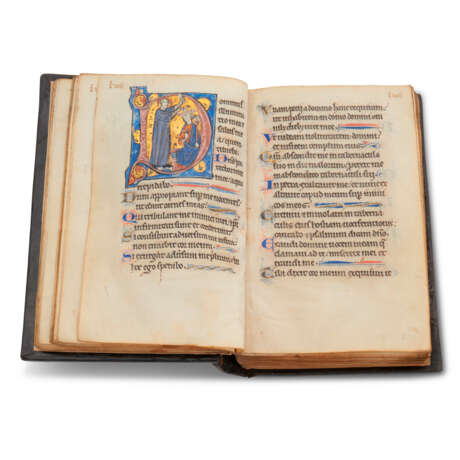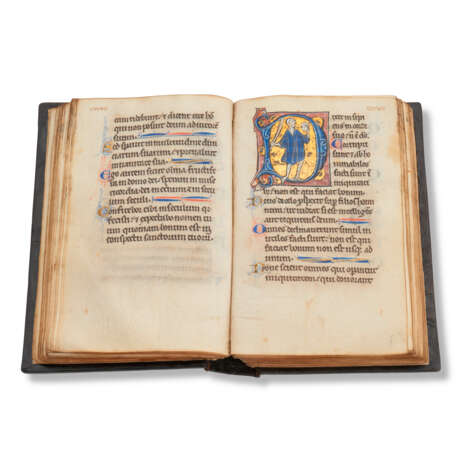ID 870870
Los 36 | Anonymous French or Flemish artist
Schätzwert
£ 20 000 – 30 000
Psalter, in Latin, illuminated manuscript on vellum [Northern France or Southern Netherlands, second half 13th century]
The influence of Paris: a 13th-century Psalter with an iconographic quirk.
164 x 113mm, 197 leaves: 116, 2-512, 611(of 10 + xi), 7- 912, 10-1216, 1312, 1411(of 12 lacking xi), 1512, 163(uncertain, lacking remainder of gathering), later pagination in Roman numerals i - cciiiixxviii, omitting x and ciiiixxiii, followed here in Arabic numerals, and in Arabic numerals 289-396, repetition of 350-359 and omission of 370-379 corrected in pencil, 18 lines, written space: 108 x 72mm, line-endings in gold and blue or blue and red, one-line initials in gold flourished with blue and in blue flourished with red, two-line initials in gold on grounds of pink and blue, large historiated initials, one with extension into border (lacking text at end and probably an opening calendar, leaf excised before p.355 but text continuous pp.354-355, trimmed into border p.289, varying wear to historiated initials, neat incisions in lower margins pp.78-81 and in upper margins pp.237-2488 and into text pp.154-7, psalm numbers and a few notes pencilled in margins). Early 19th-century roan (lower cover scuffed, joints slightly worn). Half morocco box, spine lettered gilt.
Provenance:
(1) The text offers scant evidence for intended destination; the illumination suggests an origin in the area of Northern France and the Southern Netherlands; the Roman numerals of the later pagination reflect the French numbering system.
(2) The library of the Dukes of Saxe-Meiningen, founded by Duke Bernhard I (1649-1706): library stamp HERZOGLICHER S. MEININGISCHER BIBLIOTHEK on p.1. By descent, and sold at:
(3) Christie’s, 29 November 1995, lot 7.
Contents:
The Psalms, with Ps.116 followed by Ps.119-120, pp.299-301, and Ps.117-118, pp.301-327, then continuing with Ps. 121-150, pp.1-372; Canticles, breaking after three verses of the Benedictus, pp.372-396; ?14th-century added prayers on original blanks pp.286-287.
It was usual for Psalters to be written in two sections, starting the second with Ps.109, as here p.289. The division is emphasised by writing the first two lines of text on p.1 and the first on p.289 in white capitals on pink grounds.
It seems likely that a post-Reformation Protestant owner discarded the texts that would normally accompany a Psalter, probably a calendar and various prayers and devotions, to preserve the still acceptable Biblical text.
Illumination:
The Psalter, the favoured devotional book for the laity before the Book of Hours, was traditionally divided into eight sections to be recited on the seven days of the week and at vespers, each marked by an historiated initial in Psalters of any ambition. The choice of subjects here is one often followed in Paris and Northern France, with the exception of David pointing to, probably, his eyes for Ps.97, p.244, where singers at a lectern would be expected, directly illustrating the text ‘Sing ye to the Lord’. Other scenes are occasionally found for Ps. 97, such as David praying at an altar in a complete Parisian Bible dated to the second quarter of the 13th century (Brussels KBR ms 10520). The scenes of David pointing to his eyes, probably intended here on p.244, and to his mouth probably intended on p.93, were current in Psalter iconography, as literal responses to the words of Ps.26, ‘The Lord is my light’ and Ps.38 ‘I will take heed…that I sin not with my tongue’. David’s gestures, however, were not always clearly distinguished, especially with the trend for the two scenes to be regarded as alternative possibilities for Ps 38 or, less commonly, for Ps.26. The break with convention for Ps.97 may be deliberate or accidental, just as with the altering of the usual order of the Psalms.
The initials in this Psalter are related in style as well as content to the trend setting Parisian productions of the decades before 1250 (see R. Branner, Manuscript Painting in Paris During the Reign of St Louis, 1977). In facial features, emphatic black outlines and compositional patterns, for instance, the initials are close to a Psalter in the Morgan Library, M.283, attributed to the Parisian Soissons Workshop and datable before 1247. Other aspects of the manuscript suggest an origin outside the capital in the area of Northern France and the Southern Netherlands. Parisian models were influential into the Southern Netherlands, particularly in the second half of the century, and were often followed, despite varying local traditions for Psalter illustrations (see e.g. J. Oliver, Gothic Manuscript Illumination in the Diocese of Liège (c.1259-1350), 1988; A. Stones, A Survey of Manuscripts Illuminated in France, Gothic Manuscripts 1260-1320, Parts I and 2, 2013 and 2015). The text decoration, with its compact flourishing, boldly patterned two-line initials and restrained extensions from the historiated initials, may indicate an origin towards, or in, the Southern Netherlands.
The subjects of the historiated initials are: David harping (Ps.1) p.1, David anointed by Samuel (Ps.26) p.57, David pointing to his ?mouth (Ps.38) p.93, the fool with loaf of bread and club (Ps.52) p.128, David in the waters (Ps.68) p.162, David playing the bells (Ps 80) p.205, David pointing to his ?eyes (Ps.97) p.244, the Trinity, with dragon extension into border (Ps.109) p.289.
Special notice
No VAT on hammer price or buyer's premium.
| Herkunftsort: | Belgien, Westeuropa, Frankreich, Europa |
|---|---|
| Kategorie des Auktionshauses: | Handschriften des Mittelalters und der Renaissance |
| Herkunftsort: | Belgien, Westeuropa, Frankreich, Europa |
|---|---|
| Kategorie des Auktionshauses: | Handschriften des Mittelalters und der Renaissance |
| Adresse der Versteigerung |
CHRISTIE'S 8 King Street, St. James's SW1Y 6QT London Vereinigtes Königreich | |
|---|---|---|
| Vorschau |
| |
| Telefon | +44 (0)20 7839 9060 | |
| Aufgeld | see on Website | |
| Nutzungsbedingungen | Nutzungsbedingungen |






